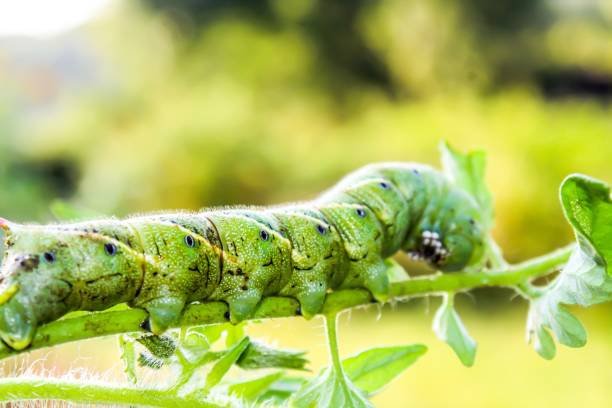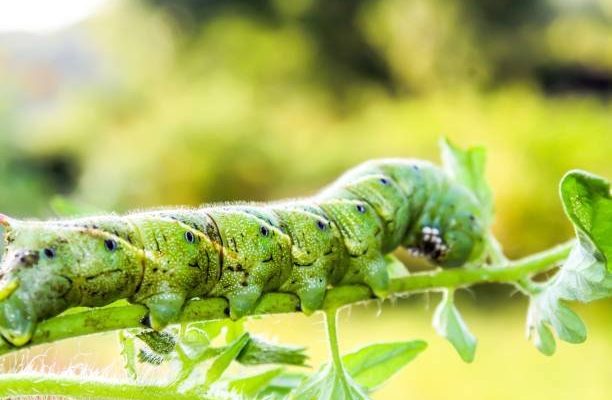
Diatomaceous earth is made from the fossilized remains of tiny aquatic organisms called diatoms. When sprinkled around your plants, this fine powder works like a tiny, microscopic sword, cutting into the soft bodies of pests such as hornworms. Honestly, it’s a little like creating a protective barrier that these intruders just can’t handle. Let’s dig deeper into hornworm control with diatomaceous earth and uncover how this simple powder can safeguard your garden.
Understanding Hornworms: What Are They?
Hornworms are the larvae of moths, typically the **five-spotted hawk moth** or the **cabbage looper**. They’re recognizable by their long, green bodies and a distinctive horn-like projection at their tail end. These caterpillars love to feast on plants in the nightshade family, which includes tomatoes, peppers, and eggplants. You might find them munching away, blending in perfectly with the leaves, making them hard to spot until the damage is done.
A common sign of a hornworm infestation is the presence of large holes in your plants’ leaves. You may even notice frass—essentially, caterpillar poop—around the base of your plants. If you suspect you have hornworms, it’s crucial to act quickly. These little monsters can devour your plants in a matter of days! Their rapid growth means that the sooner you take action, the better chance you have of saving your precious crops.
Why Choose Diatomaceous Earth for Control?
You might be wondering why diatomaceous earth is a preferable option for hornworm control compared to traditional pesticides. For starters, DE is completely natural and safe for plants, pets, and humans, making it an excellent choice for organic gardeners. It’s like having a secret weapon that doesn’t come with harmful side effects.
Here’s the thing: chemical pesticides can leave behind residues that may affect soil health and potentially harm beneficial insects. DE, on the other hand, only targets soft-bodied pests like hornworms and is harmless to many beneficial insects, such as ladybugs and bees. By using diatomaceous earth, you’re not just protecting your plants; you’re also supporting a healthier ecosystem in your garden.
How Does Diatomaceous Earth Work?
Diatomaceous earth has a unique structure that makes it effective against pests. When insects come into contact with DE, the tiny, sharp particles damage their exoskeletons, leading to dehydration and eventually death. It’s similar to walking on shards of glass for these pests!
To use DE effectively, you need to ensure you apply it correctly. Sprinkling it directly onto the leaves and surrounding ground is key. The powder needs to be dry for it to work its magic. This means that applying it after a rain or watering session might wash it away, so pick your timing carefully. As hornworms munch on your plants, they’ll inevitably come into contact with the powder, and that’s where the real battle begins.
Applying Diatomaceous Earth: Step-by-Step
Ready to take control of those hornworms with diatomaceous earth? Here’s how to do it in just a few simple steps:
- Choose Food-Grade DE: Always opt for food-grade diatomaceous earth, especially if you’re using it in a vegetable garden. It’s safe for you and your plants.
- Dry Conditions: Check the weather forecast! Make sure you apply DE on a dry day, as moisture will reduce its effectiveness.
- Application: Using a dusting applicator or a simple sieve, evenly sprinkle DE around the base of your plants and on the foliage where you see hornworm activity. Be generous!
- Reapply After Rain: Since DE is washed away by water, you’ll need to reapply it after any significant rainfall or watering session.
By following these steps, you create a barrier that hornworms won’t want to cross. Plus, it’s a straightforward method that doesn’t require complex tools or equipment.
Combining DE With Other Control Methods
While diatomaceous earth is a fantastic tool for hornworm control, it can be even more effective when used alongside other methods. For instance, consider implementing companion planting. Plants like marigolds can deter hornworms and other pests while also adding beauty to your garden. It’s like having a natural bodyguard for your crops!
Another option is introducing beneficial insects like parasitic wasps or ladybugs, which can help control pest populations naturally. Just picture your garden as a team of superheroes, each playing their part in keeping the bad guys at bay. By combining diatomaceous earth with these additional strategies, you’re setting up an effective and sustainable approach to pest control.
Common Mistakes to Avoid
When it comes to using diatomaceous earth, there are a few common pitfalls to avoid. Here are some tips to help you get the most out of your efforts:
- Over-Application: While you want to create a protective barrier, overdoing it can lead to waste. A light, even dusting is usually enough.
- Ignoring Other Signs: If you suspect hornworms, check your plants frequently. Relying solely on DE without regular inspections might mean you miss a few hungry caterpillars.
- Not Reapplying: As mentioned, DE loses its effectiveness when wet. If there’s rain, make sure to reapply—don’t let the little guys off the hook!
By avoiding these mistakes, you can effectively harness the power of diatomaceous earth in your garden.
In the battle against hornworms, diatomaceous earth is a strong ally. Its natural, safe properties make it an excellent choice for keeping your garden thriving while avoiding harmful chemicals. With a little knowledge and proper application, you can turn the tide in your favor and ensure your plants stay healthy and productive.
So, as you sip your coffee and ponder your gardening strategy, consider adding diatomaceous earth to your pest control toolbox. It’s a straightforward, effective method that can make a big difference in protecting your beloved plants. Happy gardening!

